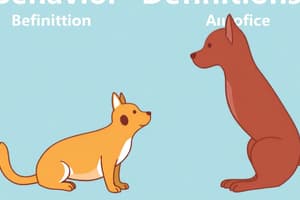Podcast
Questions and Answers
What does the definition of behavior often include?
What does the definition of behavior often include?
Measurable and detectable behavior
What may stimulus events be described by?
What may stimulus events be described by?
Where they occur temporally relative to the target behavior
Who can exhibit behavior?
Who can exhibit behavior?
Living single-celled and complex organisms
Overt behavior is not measurable.
Overt behavior is not measurable.
What does the definition of overt behavior include?
What does the definition of overt behavior include?
From a behavior-analytic perspective, what does the environment consist of?
From a behavior-analytic perspective, what does the environment consist of?
What does behavior involve?
What does behavior involve?
What effect does lifting one's finger have?
What effect does lifting one's finger have?
How can most behavior be classified?
How can most behavior be classified?
What is generally a response?
What is generally a response?
Stimuli always influence behavior.
Stimuli always influence behavior.
What forms a response class?
What forms a response class?
What is a set of behaviors that are strengthened or weakened by the same consequence called?
What is a set of behaviors that are strengthened or weakened by the same consequence called?
Select the most objective description of an event:
Select the most objective description of an event:
Which of the following may be a stimulus? (Select all that apply)
Which of the following may be a stimulus? (Select all that apply)
All stimuli in a class exert control over behavior due to a single common feature.
All stimuli in a class exert control over behavior due to a single common feature.
What is a fundamental aspect of respondent behavior?
What is a fundamental aspect of respondent behavior?
What is a reflex?
What is a reflex?
Which of the following is synonymous with respondent conditioning?
Which of the following is synonymous with respondent conditioning?
What is the definition of a conditioned stimulus?
What is the definition of a conditioned stimulus?
What must occur for reinforcement to be effective?
What must occur for reinforcement to be effective?
Which statement is true about operant behaviors?
Which statement is true about operant behaviors?
What does escape do?
What does escape do?
In operant conditioning, what is stimulus control a function of?
In operant conditioning, what is stimulus control a function of?
Who exhibits operant relations?
Who exhibits operant relations?
What is the positive reinforcement exemplified by?
What is the positive reinforcement exemplified by?
What may serve as negative reinforcement?
What may serve as negative reinforcement?
What is contrived reinforcement?
What is contrived reinforcement?
What does naturally occurring reinforcement refer to?
What does naturally occurring reinforcement refer to?
What does the quality of a reinforcer refer to?
What does the quality of a reinforcer refer to?
A benefit of using a generalized reinforcer is: (Select all that apply)
A benefit of using a generalized reinforcer is: (Select all that apply)
Flashcards are hidden until you start studying
Study Notes
Definitions of Behavior
- Behavior definitions often prioritize measurable and detectable actions.
- Covert behavior, such as emotional states, is frequently excluded from definitions.
Stimulus Events
- Descriptions of stimulus events focus on their temporal occurrence relative to target behavior.
Behavior Exhibited
- Behavior can be exhibited by various organisms, from single-celled to complex multicellular entities.
Overt Behavior
- Overt behavior is characterized by measurability and is observable.
Defining Overt Behavior
- Key features include:
- Movement of some part of the organism.
- A measurable change in the environment.
- Displacement occurring in space over time.
Environment in Behavior Analysis
- In behavior analysis, the environment consists of stimulus conditions or events impacting behavior.
Movement of Muscles and Glands
- Behavior is fundamentally linked to the activity of muscles and glands.
Behavioral Impact
- Actions like lifting a finger affect the surrounding environment.
Classification of Behavior
- Most behavior can be classified as:
- Overt vs. covert.
- Operant vs. respondent.
- By response class.
Response Definition
- A response is considered a single instance of behavior.
Role of Stimuli
- Stimuli influence receptor systems within organisms but do not necessarily affect behavior directly.
Response Class Features
- Behaviors differing in topography may be strengthened or weakened by the same consequence, forming a response class.
Objective Event Descriptions
- Objectively describing an event focuses on observable facts, e.g., environmental noise levels affecting communication.
Stimulus Examples
- Movements performed by the organism, responses from others, and gradual temperature changes can serve as stimuli.
Control by Stimulus Class
- A group of stimuli can exert behavioral control due to shared common features.
Examples of Stimulus Classes
- Members may include:
- Stop signs and traffic control signals.
- Items of the same color or category, like blue objects.
Objective Event Accounts
- An accurate description highlights quantifiable metrics, such as the number of children in a classroom.
Definition of a Response Class
- A response class is defined by a group of behaviors that are affected by a common consequence.
Reflex Understanding
- A reflex consists of a response and its associated controlling stimulus.
Respondent Behavior Characteristics
- Respondent behavior is controlled by antecedent stimuli and cannot be easily shaped.
Unconditioned Stimulus Responses
- An unconditioned stimulus elicits an unconditioned response without prior conditioning.
Pavlovian Conditioning
- Respondent conditioning is synonymous with Pavlovian conditioning.
Requirements for Respondent Conditioning
- Involves pairing a neutral stimulus with an unconditioned stimulus to elicit responses.
Examples of Respondent Behavior
- Automatic reactions, such as blushing, exemplify respondent behavior.
Respondent Relationships
- Respondent relationships are framed as S-R (stimulus-response) dynamics.
Conditioned Stimulus Understanding
- A previously neutral stimulus becomes a conditioned stimulus by being associated with an unconditioned stimulus.
Examples of Unconditioned Stimuli
- Examples include sounds, bright lights, and other stimuli that provoke direct responses.
Operant Behavior Definition
- Operant behaviors are defined by their functional effects on the environment.
Operant Conditioning Dynamics
- Reinforcement is identified by the relationship between behavior and its consequences.
Escape Responses
- Escape behavior increases the likelihood of the preceding action in negative reinforcement contexts.
Stimulus Control in Operant Conditioning
- Control is established through antecedents and consequences influencing behavior.
Operant Relations Structure
- Represented as S-R-S (stimulus-response-stimulus) interactions.
Conditions for Reinforcement
- Reinforcement occurs when behavior effectively produces a favorable consequence, leading to increased future occurrences.
Transitioning Behavior from Respondent to Operant
- An unconditioned response may evolve into an operant through conditioning processes.
Positive Reinforcement Effects
- Teacher reprimands generating increased teasing behavior illustrate positive reinforcement dynamics.
Negative Reinforcement Example
- Temporary relief from pain serves as a negative reinforcer, promoting specific behaviors.
Operant Selection Explained
- Responses yielding reinforcing consequences become entrenched in an individual's behavior repertoire.
Child and Reinforcement Dynamics
- When a child’s request for a snack results in fulfillment, the behavior exemplifies positive reinforcement.
Maintaining Establishing Operations
- Generalized reinforcers can maintain potency due to their wide applicability and resistance to satiation.
The Quality of Reinforcers
- Refers to individual preferences impacting the effectiveness of the reinforcer.
Generalized Reinforcers Benefits
- Generalized reinforcers are resistant to satiation and provide broad applicability across behaviors.
Premack Principle Understanding
- Higher probability behaviors can be utilized to reinforce lower probability behaviors effectively.
Restriction and Access in Behavior
- Limiting access to preferred activities may result in increased engagement in less preferred tasks.
Introduction of Descriptive Praise
- Functions as a positive reinforcer and guides future behavior, emphasizing specific behaviors.
Satiation Influence
- A reinforcer's effectiveness can diminish due to excessive exposure or frequency of delivery.
Choice in Academic Settings
- Providing choice among tasks correlates to reduced disruptive behaviors and increased compliance.
Rule Following Behaviors
- Defined by frequency changes, substantial responses following reinforcement, and occurrence without immediate consequences.
Control Shift from Contrived Reinforcers
- Transitioning to naturally occurring reinforcers involves teaching behaviors that yield natural consequences.
Techniques for Delayed Reinforcement
- Bridging activities or verbal reassurances can facilitate learning delayed reinforcement responses.
Naturally Occurring Reinforcement
- Engagement in behavior without contrived intervention leads to authentic reinforcement.
Functional Relationships in Respondent Conditioning
- Respondent contingencies define connections among stimuli and are essential for learning processes.
Contingency Relationships in Behavior
- Dependent relationships in response classes define how stimuli influence behaviors collectively.
Studying That Suits You
Use AI to generate personalized quizzes and flashcards to suit your learning preferences.




